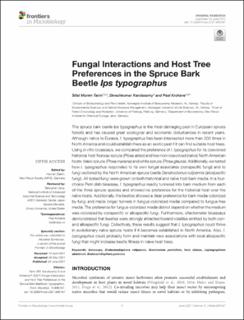| dc.contributor.author | Tanin, Sifat Munim | |
| dc.contributor.author | Kandasamy, Dineshkumar | |
| dc.contributor.author | Krokene, Paal | |
| dc.date.accessioned | 2021-07-26T11:50:30Z | |
| dc.date.available | 2021-07-26T11:50:30Z | |
| dc.date.created | 2021-06-28T09:53:48Z | |
| dc.date.issued | 2021 | |
| dc.identifier.citation | Frontiers in Microbiology. 2021, 12 . | |
| dc.identifier.issn | 1664-302X | |
| dc.identifier.uri | https://hdl.handle.net/11250/2765282 | |
| dc.description.abstract | The spruce bark beetle Ips typographus is the most damaging pest in European spruce forests and has caused great ecological and economic disturbances in recent years. Although native to Eurasia, I. typographus has been intercepted more than 200 times in North America and could establish there as an exotic pest if it can find suitable host trees. Using in vitro bioassays, we compared the preference of I. typographus for its coevolved historical host Norway spruce (Picea abies) and two non-coevolved (naïve) North American hosts: black spruce (Picea mariana) and white spruce (Picea glauca). Additionally, we tested how I. typographus responded to its own fungal associates (conspecific fungi) and to fungi vectored by the North American spruce beetle Dendroctonus rufipennis (allospecific fungi). All tested fungi were grown on both historical and naïve host bark media. In a four-choice Petri dish bioassay, I. typographus readily tunneled into bark medium from each of the three spruce species and showed no preference for the historical host over the naïve hosts. Additionally, the beetles showed a clear preference for bark media colonized by fungi and made longer tunnels in fungus-colonized media compared to fungus-free media. The preference for fungus-colonized media did not depend on whether the medium was colonized by conspecific or allospecific fungi. Furthermore, olfactometer bioassays demonstrated that beetles were strongly attracted toward volatiles emitted by both con- and allospecific fungi. Collectively, these results suggest that I. typographus could thrive in evolutionary naïve spruce hosts if it becomes established in North America. Also, I. typographus could probably form and maintain new associations with local allospecific fungi that might increase beetle fitness in naïve host trees. | |
| dc.language.iso | eng | |
| dc.title | Fungal Interactions and Host Tree Preferences in the Spruce Bark Beetle Ips typographus | |
| dc.title.alternative | Fungal Interactions and Host Tree Preferences in the Spruce Bark Beetle <i>Ips typographus</i> | |
| dc.type | Peer reviewed | |
| dc.type | Journal article | |
| dc.description.version | publishedVersion | |
| dc.source.pagenumber | 12 | |
| dc.source.volume | 12 | |
| dc.source.journal | Frontiers in Microbiology | |
| dc.identifier.doi | 10.3389/fmicb.2021.695167 | |
| dc.identifier.cristin | 1918796 | |
| cristin.ispublished | true | |
| cristin.fulltext | original | |
| cristin.qualitycode | 2 | |
